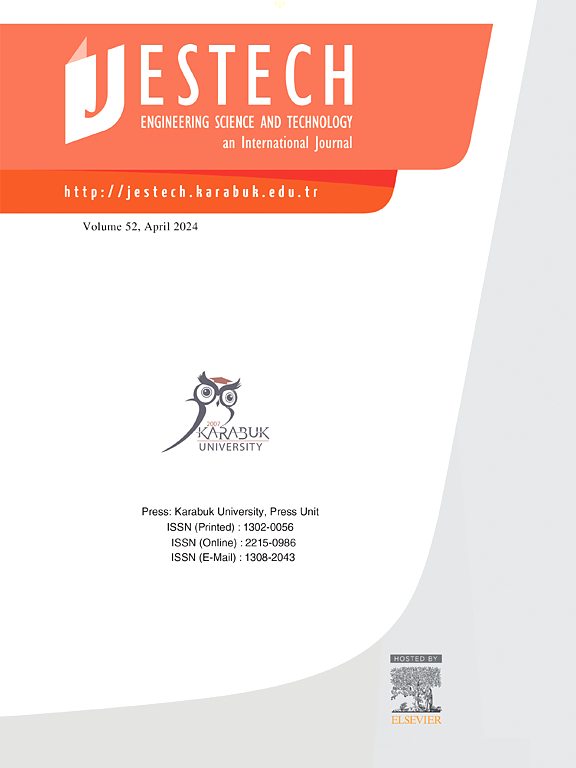Integrated biomimetic biphasic structures for high-strain-rate resistance and thermal insulation: Design, fabrication and performance characterization
IF 5.4
2区 工程技术
Q1 ENGINEERING, MULTIDISCIPLINARY
Engineering Science and Technology-An International Journal-Jestech
Pub Date : 2025-05-16
DOI:10.1016/j.jestch.2025.102088
引用次数: 0
Abstract
Addressing the critical need for multifunctional protective structures in military vehicles, this paper proposes three novel biphasic structures integrating high-strain-rate resistance and thermal insulation. Natural organisms have evolved lightweight, strong, and durable structures through long-term evolutionary adaptation. Guided by the tenets of biomimicry, three high-strain-rate resistant structural frameworks are firstly proposed and fabricated using 3D printing technology. Biphasic structures are fabricated by infusing phenolic resin into three novel structural frameworks through solution impregnation and thermal curing, followed by room temperature drying. The high-strain-rate resistances of the three biphasic structures are analyzed and compared employing Split Hopkinson Pressure Bar (SHPB) experiments, with the deformation process recorded via a high-speed camera. Based on micro-computerized tomography (μ-CT) images, the structural characteristics and porosity of the three biphasic structures after SHPB experiment are acquired. The thermal insulation properties of the structures are characterized using hot plate test and butane torch test. The dynamic mechanical properties and heat transfer mechanisms of the three biphasic structures are further analyzed using finite element simulations. The results show that the three structures exhibit both high-strain-rate resistance and thermal insulation properties, with the G-TPMS biphasic structure having the superior overall performance.
集成仿生双相结构的高应变率电阻和隔热:设计,制造和性能表征
针对军用车辆对多功能防护结构的迫切需求,提出了三种新型高应变率和隔热相结合的双相防护结构。通过长期的进化适应,自然生物进化出了轻、强、耐用的结构。在仿生学原理的指导下,首次提出并利用3D打印技术制作了三种高应变率抗结构框架。将酚醛树脂注入三种新型结构框架中,通过溶液浸渍和热固化,然后进行室温干燥,制成双相结构。采用分离式霍普金森压杆(Split Hopkinson Pressure Bar, SHPB)实验对三种双相结构的高应变率电阻进行了分析和比较,并通过高速摄像机记录了变形过程。基于微计算机断层扫描(μ-CT)图像,获得了SHPB实验后三种双相结构的结构特征和孔隙率。采用热板试验和丁烷火炬试验对结构的保温性能进行了表征。利用有限元模拟进一步分析了三种双相结构的动态力学性能和传热机理。结果表明:三种结构均具有较高的抗应变速率和保温性能,其中G-TPMS双相结构的综合性能更优。
本文章由计算机程序翻译,如有差异,请以英文原文为准。
求助全文
约1分钟内获得全文
求助全文
来源期刊

Engineering Science and Technology-An International Journal-Jestech
Materials Science-Electronic, Optical and Magnetic Materials
CiteScore
11.20
自引率
3.50%
发文量
153
审稿时长
22 days
期刊介绍:
Engineering Science and Technology, an International Journal (JESTECH) (formerly Technology), a peer-reviewed quarterly engineering journal, publishes both theoretical and experimental high quality papers of permanent interest, not previously published in journals, in the field of engineering and applied science which aims to promote the theory and practice of technology and engineering. In addition to peer-reviewed original research papers, the Editorial Board welcomes original research reports, state-of-the-art reviews and communications in the broadly defined field of engineering science and technology.
The scope of JESTECH includes a wide spectrum of subjects including:
-Electrical/Electronics and Computer Engineering (Biomedical Engineering and Instrumentation; Coding, Cryptography, and Information Protection; Communications, Networks, Mobile Computing and Distributed Systems; Compilers and Operating Systems; Computer Architecture, Parallel Processing, and Dependability; Computer Vision and Robotics; Control Theory; Electromagnetic Waves, Microwave Techniques and Antennas; Embedded Systems; Integrated Circuits, VLSI Design, Testing, and CAD; Microelectromechanical Systems; Microelectronics, and Electronic Devices and Circuits; Power, Energy and Energy Conversion Systems; Signal, Image, and Speech Processing)
-Mechanical and Civil Engineering (Automotive Technologies; Biomechanics; Construction Materials; Design and Manufacturing; Dynamics and Control; Energy Generation, Utilization, Conversion, and Storage; Fluid Mechanics and Hydraulics; Heat and Mass Transfer; Micro-Nano Sciences; Renewable and Sustainable Energy Technologies; Robotics and Mechatronics; Solid Mechanics and Structure; Thermal Sciences)
-Metallurgical and Materials Engineering (Advanced Materials Science; Biomaterials; Ceramic and Inorgnanic Materials; Electronic-Magnetic Materials; Energy and Environment; Materials Characterizastion; Metallurgy; Polymers and Nanocomposites)
 求助内容:
求助内容: 应助结果提醒方式:
应助结果提醒方式:


